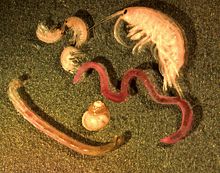
| Marine habitats |
|---|
| Coastal habitats |
| Ocean surface |
| Open ocean |
| Sea floor |
The benthic zone is the ecological region at the lowest level of a body of water such as an ocean, lake, or stream, including the sediment surface and some sub-surface layers. The name comes from the Ancient Greek word βένθος (bénthos), meaning "the depths".[1] Organisms living in this zone are called benthos and include microorganisms (e.g., bacteria and fungi)[2][3] as well as larger invertebrates, such as crustaceans and polychaetes.[4] Organisms here generally live in close relationship with the substrate and many are permanently attached to the bottom. The benthic boundary layer, which includes the bottom layer of water and the uppermost layer of sediment directly influenced by the overlying water, is an integral part of the benthic zone, as it greatly influences the biological activity that takes place there. Examples of contact soil layers include sand bottoms, rocky outcrops, coral, and bay mud.
- ^
 The dictionary definition of benthos at Wiktionary
The dictionary definition of benthos at Wiktionary
- ^ Wetzel, Robert G. (2001). Limnology: Lake and River Ecosystems, 3rd edn. Academic Press, San Diego. pp. 635–637.
- ^ Fenchel, T.; King, G.; Blackburn, T. H. (2012). Bacterial Biogeochemistry: The Ecophysiology of Mineral Cycling, 3rd edn. Academic Press, London. pp. 121–122.
- ^ "What Are Benthos?". Baybenthos.versar.com. 2006-01-23. Retrieved 2013-11-24.